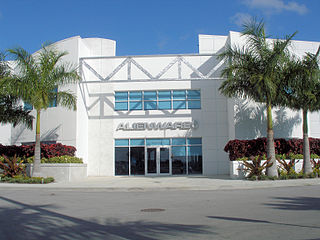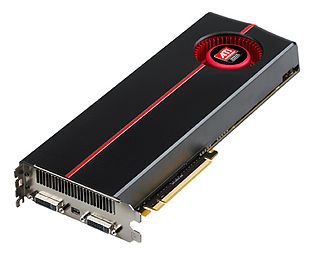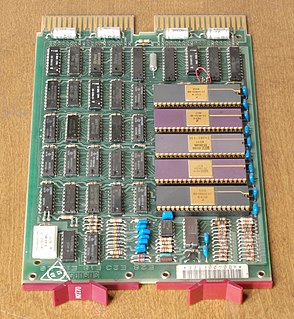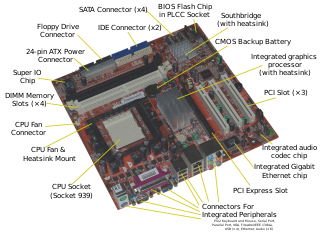
A motherboard is the main printed circuit board (PCB) in general-purpose computers and other expandable systems. It holds and allows communication between many of the crucial electronic components of a system, such as the central processing unit (CPU) and memory, and provides connectors for other peripherals. Unlike a backplane, a motherboard usually contains significant sub-systems, such as the central processor, the chipset's input/output and memory controllers, interface connectors, and other components integrated for general use.

A graphics card is an expansion card which generates a feed of output images to a display device, such as a computer monitor. Graphics cards are sometimes called discrete or dedicated graphics cards to emphasize their distinction to integrated graphics. A graphics processing unit that performs the necessary computations is the main component of a graphics card, but the acronym "GPU" is sometimes also used to refer to the graphics card as a whole.

GeForce is a brand of graphics processing units (GPUs) designed by Nvidia. As of the GeForce 30 series, there have been seventeen iterations of the design. The first GeForce products were discrete GPUs designed for add-on graphics boards, intended for the high-margin PC gaming market, and later diversification of the product line covered all tiers of the PC graphics market, ranging from cost-sensitive GPUs integrated on motherboards, to mainstream add-in retail boards. Most recently, GeForce technology has been introduced into Nvidia's line of embedded application processors, designed for electronic handhelds and mobile handsets.

In computing, overclocking is the practice of increasing the clock rate of a computer to exceed that certified by the manufacturer. Commonly, operating voltage is also increased to maintain a component's operational stability at accelerated speeds. Semiconductor devices operated at higher frequencies and voltages increase power consumption and heat. An overclocked device may be unreliable or fail completely if the additional heat load is not removed or power delivery components cannot meet increased power demands. Many device warranties state that overclocking or over-specification voids any warranty, however there are an increasing number of manufacturers that will allow overclocking as long as performed (relatively) safely.

A graphics processing unit (GPU) is a specialized electronic circuit designed to manipulate and alter memory to accelerate the creation of images in a frame buffer intended for output to a display device. GPUs are used in embedded systems, mobile phones, personal computers, workstations, and game consoles.

In computing, a northbridge is one of two chips comprising the core logic chipset architecture on a PC motherboard. A northbridge is connected directly to a CPU via the front-side bus (FSB) to handle high-performance tasks, and is usually used in conjunction with a slower southbridge to manage communication between the CPU and other parts of the motherboard. Since the 2010s, die shrink and improved transistor density have allowed for increasing chipset integration, and the functions performed by northbridges are now often incorporated into other components. As of 2019, Intel and AMD had both released chipsets in which all northbridge functions had been integrated into the CPU. Modern Intel Core processors have the northbridge integrated on the CPU die, where it is known as the uncore or system agent.

Alienware is an American computer hardware subsidiary of Dell. Their product range is dedicated to gaming computers which can be identified by their alien-themed designs. Alienware was founded in 1996 by Nelson Gonzalez and Alex Aguila, and is currently led by Vivian Lien. The development of the company is also associated with Frank Azor, Arthur Lewis, Joe Balerdi, and Michael S. Dell. The company's corporate headquarters is located in The Hammocks, Miami, Florida.

Scalable Link Interface (SLI) is a brand name for a deprecated multi-GPU technology developed by Nvidia for linking two or more video cards together to produce a single output. SLI is a parallel processing algorithm for computer graphics, meant to increase the available processing power.
Dell XPS is a line of consumer-oriented high-end laptop and desktop computers manufactured by Dell. The XPS mainly competes against computers such as Acer's Aspire, HP's Pavilion and Envy, Lenovo's X1, Samsung's Sens, and Apple MacBook Pro.
A physics processing unit (PPU) is a dedicated microprocessor designed to handle the calculations of physics, especially in the physics engine of video games. It is an example of hardware acceleration.

The GeForce 7 series is the seventh generation of Nvidia's GeForce graphics processing units. This was the last series available on AGP cards.

Graphics hardware is computer hardware that generates computer graphics and allows them to be shown on a display, usually using a graphics card in combination with a device driver to create the images on the screen.
A gaming computer, also known as a gaming PC, is a specialized personal computer designed for playing video games at very high standards. Gaming PCs typically differ from mainstream personal computers by using high-performance video cards, a high core-count central processing units with raw performance and higher-performance RAM. Gaming PCs are also used for other demanding tasks such as video editing. Many gamers and computer enthusiasts choose to overclock their CPUs and GPUs in order to gain extra performance. The added power draw needed to overclock either processing units often requires additional cooling, usually by air cooling or water cooling.

The RSX 'Reality Synthesizer' is a proprietary graphics processing unit (GPU) codeveloped by Nvidia and Sony for the PlayStation 3 game console. It is a GPU based on the Nvidia 7800GTX graphics processor and, according to Nvidia, is a G70/G71 hybrid architecture with some modifications. The RSX has separate vertex and pixel shader pipelines. The GPU makes use of 256 MB GDDR3 RAM clocked at 650 MHz with an effective transmission rate of 1.3 GHz and up to 224 MB of the 3.2 GHz XDR main memory via the CPU . Although it carries the majority of the graphics processing, the Cell Broadband Engine, the console's CPU, is also used complementarily for some graphics-related computational loads of the console.
The GeForce 8 series is the eighth generation of Nvidia's GeForce line of graphics processing units. The third major GPU architecture developed by Nvidia, Tesla represents the company's first unified shader architecture.
NVIDIA System Tools is a discontinued collection of utilities for accessing, monitoring, and adjusting system components, including temperature and voltages with a graphical user interface within Windows, rather than through the BIOS.

Computer hardware includes the physical parts of a computer, such as the case, central processing unit (CPU), random access memory (RAM), monitor, mouse, keyboard, computer data storage, graphics card, sound card, speakers and motherboard.

GPU switching is a mechanism used on computers with multiple graphic controllers. This mechanism allows the user to either maximize the graphic performance or prolong battery life by switching between the graphic cards. It is mostly used on gaming laptops which usually have an integrated graphic device and a discrete video card.

The GeForce 600 series is a series of graphics processing units developed by Nvidia, first released in 2012. They served as the introduction of the Kepler architecture.

The GeForce 20 series is a family of graphics processing units developed by Nvidia. Serving as the successor to the GeForce 10 series, the line started shipping on September 20, 2018, and after several editions, on July 2, 2019, the GeForce RTX Super line of cards was announced.


















